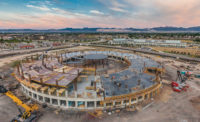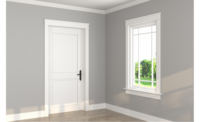New Company Headquarter Burns Less Energy
Burns & McDonnell World Headquarters named Mid-America Region Project of the Year due to sustainability.
















Less than two years after breaking ground on a once-blighted, 17.5-acre site adjacent to its world headquarters, Burns & McDonnell is welcoming employee-owners, clients and friends into one of the most dramatic transformations in Kansas City. Now, serving as the anchor to the famed Ward Parkway corridor, the four-story, 310,000-square-foot facility is the third building on the firm’s 37-acre campus. Burns & McDonnell partnered with VanTrust Real Estate on the expansion project that increases the size of its world headquarters by 74 percent, accommodating 1,400 additional employee-owners.
“This is much more than a nice new building,” says Greg Graves, chairman and CEO, Burns & McDonnell. “It’s our identity. We intentionally designed it to mirror the values and principles of Burns & McDonnell. For example, the glass wall around the first floor symbolizes our transparency as a firm. The open design and unique gathering stations illustrate our passion for partnership and collaboration. And hand-selected amenities illustrate our commitment to our employee-owners and making Burns & McDonnell the best place to work.”
The recently completed World Headquarters has been named Project of the Year in the Mid-America Region by the Design-Build Institute of America (DBIA). The 310,000 square-foot, 4-story building also received top honors in the Commercial Buildings category in the annual DBIA competition.
Design-Build Project Delivery
The expansion project spanned 17 months, required 345,000 man-hours for completion and had zero safety incidents. The project team credits the integrated design-build delivery method for staying within the $85 million budget. Uniquely Burns & McDonnell, integrated design-build is an approach in which one team of architects, engineers, constructors and other professionals work collaboratively to see that all project details are executed to perfection from conception to occupancy.
“Changes always happen during a project and typically those can mean added costs,” says Lori Top, the Burns & McDonnell architect who led the design team. “Having an agile design-build team allowed us to make better cost decisions early in the project. We maximized the money we saved and put it towards areas that provide the most value to employee-owners, such as the pharmacy and the barista coffee bar. That’s the beauty of integrated design-build.”
“The Burns & McDonnell expansion project has become a model of how to do commercial projects,” says David Harrison, president of VanTrust Real Estate that served as both the client and partner for the project. “We regularly toured clients and colleagues through the project during construction to have them experience the energy and efficiency of the job in action. We count on projects to exceed our expectations and arrive on budget, and this one hit the mark and then some.”
The project, developed by VanTrust Real Estate on a 17.5-acre site that previously was occupied for many years by Beth Shalom synagogue, began in 2013 when Burns & McDonnell reached agreement with VanTrust to serve as designer, builder and sole occupant. The new building sits adjacent to the preexisting Burns & McDonnell headquarters complex at 9400 Ward Parkway. Demolition began in July 2014 and construction commenced in October of that year. The $75 million project was completed in March 2016, 17 months from the construction start date and nearly $5 million under the original budget. The project required 345,000 man-hours for completion and had zero safety incidents.
"On behalf of the DBIA, we congratulate Burns & McDonnell for its beautiful new headquarters building," says Oretta Smith, executive director of DBIA-Mid-America Region. "This amazing project proves once again that design-build is the most effective method to meet an aggressive schedule and owner expectations of cost certainty."
"We're extremely proud of our new home and doubly gratified that it has been recognized as Project of the Year by the DBIA," says Greg Graves, chairman and CEO of Burns & McDonnell. "This project could not have gone better, starting with a great partner and developer in VanTrust. We believe our building can serve as a case study of the value of integrated design-build, a project delivery model that Burns & McDonnell has perfected over the years by having architects, engineers, construction professionals and all other relevant disciplines under one roof."
The project was developed to expand and consolidate operations at Burns & McDonnell's world headquarters campus in South Kansas City. The new building is now home to 1,400 employee owners and expands total capacity at the headquarters complex to 3,500. The new facility was designed as a showcase of great design and sustainable, energy-saving features. It incorporates a number of new workspace concepts, employee collaboration areas and amenities including a health center, pharmacy, credit union, event spaces and 250-seat auditorium. An especially notable amenity is the MacKids Learning Academy, a 20,000-square-foot child care center with capacity for 144 pre-school-aged children of Burns & McDonnell employees.
"There is so much we are proud of with this new headquarters, it's hard to know where to start but of course the MacKids Learning Academy is high on the list," says Lori Top, Design Principle in Charge of the 9450 project. "The academy is designed and intended to foster a love of STEM (science, technology, engineering and math) among the next generation of Burns & Mac children. What a gratifying way to give back to your fellow employee owners, by teaching their children to love the STEM fields as we do."
Sustainability
Sustainability and energy savings were central elements of all design and construction decisions. The building achieves exceptional energy efficiency thanks to high-performance HVAC systems, LED lighting and other features. Another key sustainability goal was to achieve maximum daylighting while controlling thermal heat gain from sunlight pouring through large exterior windows around the perimeter of the entire building. An advanced "smart" window shading system controls heat gain and sunlight by automatically raising or lowering the shades based on signals from rooftop sensors that track the movement and cloud cover of the sun.
The project team infused sustainable design throughout the entire process. One of the most challenging, yet rewarding initiatives was rerouting a stream to mirror its original path for the first time in nearly a half-century. Crews constructed a bioretention and storage system along the drainage basin featuring plants and materials that absorb and naturally filter the runoff.
Additional sustainable elements include:
- Reclaimed white marble, from the lobby of the synagogue that previously occupied the site, repurposed for use in conference rooms and public spaces
- Hackberry wood, native to the Midwest, used for unique feature walls, veneers and ceiling panels
- 100 percent LED lighting paired with daylight harvesting for optimal energy savings
- More than 300 tons of recycled steel and metal
- Reuse of 7,000 tons of processed concrete and masonry
- Electric vehicle charging stations included in the new five-level parking garage
"We routinely take on the toughest challenges for our clients and we think this building is just more evidence of our ability to come through for them," says Graves. "This was not an easy project but those are the kind of challenges we really love."
Looking for a reprint of this article?
From high-res PDFs to custom plaques, order your copy today!
















